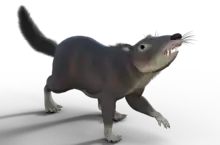Gobiconodon
Gobiconodon is an extinct genus of carnivorous mammal from the early Cretaceous. It weighed 10–12 pounds (4.5–5.4 kg) and measured 18–20 inches (460–510 mm). It was one of the largest mammals known from the Mesozoic. Like other gobiconodontids, it possesses several speciations towards carnivory, such as shearing molar teeth, large canine-like incisors and powerful jaw and forelimb musculature, indicating that it probably fed on vertebrate prey; rather uniquely among predatory mammals and other eutriconodonts, the lower canines were vestigial, with the first lower incisor pair having become massive and canine-like. Like the larger Repenomamus there might be some evidence of scavenging.[2]
| Gobiconodon | |
|---|---|
| Reconstruction | |
| Gobiconodon ostromi skeleton | |
| Scientific classification | |
| Kingdom: | Animalia |
| Phylum: | Chordata |
| Class: | Mammalia |
| Order: | †Gobiconodonta |
| Family: | †Gobiconodontidae |
| Genus: | †Gobiconodon Trofimov, 1978 |
| Species | |
| |
| Synonyms | |
| |
Species
| Species | Material | Age | Location | Unit | Notes |
|---|---|---|---|---|---|
| G. borissiaki [3] | 10 upper and lower jaws[3] & 3 upper and lower jaws.[4] Holotype: PIN 3101/09 | Aptian - Albian | Khoboor Beds | Neoconodon is a synonym. | |
| 1 fragmentary lower jaw[5] | Neocomian - Albian | Siberia | |||
| G. hoburensis [3] | 21 upper and lower jaws. Holotype: PIN 3101/24 | Aptian - Albian | Khoboor Beds; Siberia | Guchinodon hoburensis is a synonym.[4] The smallest Gobiconodon. | |
| G. hopsoni [6] | 2 upper and lower jaws (PSS-MAE 140 (Holotype) & PSS-MAE 139) | ?Vanginian - Neocomian | Oshih Formation | The largest Gobiconodon. | |
| G. palaios [7] | Tithonian-Berriasian | Ksar Metlili Formation | |||
| Gobiconodon sp.[6] | 2 fragmentary lower jaws | ?Vanginian - Neocomian | Oshih Formation | ||
| G. sp. A[8] | Lower Cretaceous | Ilek Formation | |||
| G. sp. B[8] | Lower Cretaceous | Ilek Formation | |||
| G. luoianus [9] | Nearly complete skull (41H III-0320 (Holotype)) | Aptian | Yixian Formation | ||
| G. ostromi [10] | 2 incomplete skeletons (MCZ 19965 (Holotype) & MCZ 19860) | Aptian - Albian | Cloverly Formation | ||
| G. zofiae [11] | Partial skull and lower jaws (IVPP V12585 (Holotype)) | Hauterivian | Yixian Formation | ||
| G. bathoniensis [12] | Two upper left molars and last upper right molar | Bathonian | Forest Marble Formation |
References
- Nao Kusuhashi; Yuan-Qing Wang; Chuan-Kui Li; Xun Jin (2015). "Two new species of Gobiconodon (Mammalia, Eutriconodonta, Gobiconodontidae) from the Lower Cretaceous Shahai and Fuxin formations, northeastern China". Historical Biology: An International Journal of Paleobiology. 28 (1–2): 14–26. doi:10.1080/08912963.2014.977881.
- Zofia Kielan-Jaworowska, Richard L. Cifelli, Zhe-Xi Luo (2004). "Chapter 7: Eutriconodontans". Mammals from the Age of Dinosaurs: origins, evolution, and structure. New York: Columbia University Press. pp. 216–248. ISBN 0-231-11918-6.
- Trofimov, B. A. (1978). "The first triconodonts (Mammalia, Triconodonta) from Mongolia". Doklady Akademii Nauk SSSR. 243 (1): 213–216.
- Kielan-Jaworowska, Z.; Dashzeveg, D. (1998). "Early Cretaceous amphilestid ("triconodont") mammals from Mongolia" (PDF). Acta Palaeontologica Polonica. 43 (3): 413–438.
- Maschenko, E. N.; Lopatin, A. V. (1998). "First record of an Early Cretaceous triconodont mammal in Siberia". Bull. Inst. R. Sci. Nat. Belg. 68: 233–236.
- Rougier; Novacek; McKenna & Wible (2001). "Gobiconodonts from the Early Cretaceous of Oshih (Ashile), Mongolia" (PDF). American Museum Novitates. 3348: 1–30. doi:10.1206/0003-0082(2001)348<0001:GFTECO>2.0.CO;2. ISSN 0003-0082.
- Sigogneau-Russell Denise (2003). "Diversity of triconodont mammals from the early Cretaceous of north Africa: Affinities of the amphilestids". Palaeovertebrata. 32 (1): 27–55.
- Alexander O. Averianov; Pavel P. Skutschas; Alexey V. Lopatin; Sergei V. Leshchinskiy; Anton S. Rezvyi; Alexey V. Fayngerts (2005). "Diversity Early Cretaceous mammals from Bol'shoi Kemchug 3 locality in West Siberia, Russia" (PDF). Russian Journal of Theriology. 4 (1): 1–12.
- Yuan Chongxi; Xu Li; Zhang Xingliao; Xi Yunhong; Wu Yanhua; Ji Qiang (2009). "A New Species of Gobiconodon (Mammalia) from Western Liaoning, China and its Implication for the Dental Formula of Gobiconodon". Acta Geologica Sinica. 83 (2): 207–211. doi:10.1111/j.1755-6724.2009.00035.x.
- F. A. Jenkins; C. R. Schaff (1988). "The Early Cretaceous mammal Gobiconodon (Mammalia, Triconodonta) from the Cloverly Formation in Montana". Journal of Vertebrate Paleontology. 8 (1): 1–24. doi:10.1080/02724634.1988.10011681. JSTOR 4523172.
- Li Chuankui; Wang Yuanqing; Hu Yaoming; Meng Jin (2003). "A new species of Gobiconodon(Triconodonta, Mammalia)and its implication for theage of Jehol Biota" (PDF). Chinese Science Bulletin. 48 (11): 1129–1134. doi:10.1360/02wd0134.
- Percy M. Butler; Denise Sigogneau-Russell (2016). "Diversity of triconodonts in the Middle Jurassic of Great Britain" (PDF). Palaeontologia Polonica 67: 35–65. doi:10.4202/pp.2016.67_035.
This article is issued from Wikipedia. The text is licensed under Creative Commons - Attribution - Sharealike. Additional terms may apply for the media files.





